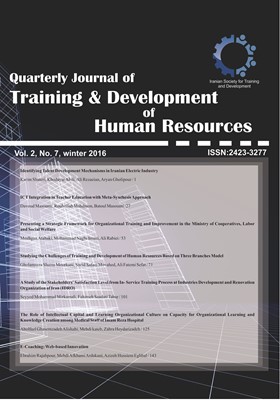Presenting a Strategic Framework for Organizational Training and Improvement in the Ministry of Cooperatives, Labor and Social Welfare
Subject Areas :مژگان اتابکی 1 , محمدنقی ايماني گله پردسری 2 , علی ربیعی 3
1 -
2 -
3 -
Keywords: Training and Improvement Strategic Management of Human Resources Human Capitals,
Abstract :
This study aims to provide a strategic Training and Improvement framework for human capital in the Ministry of Cooperatives, Labor and Social Welfare. The methodology used here is descriptive and hybrid, i.e. a combination of quantitative and qualitative methods. Research tool is a questionnaire so that it was first presented to experts and after applying their comments on the questionnaire, the ultimate version of the research’s model was designed and implemented in three stages. After finalizing the pattern as above, in order to implement the survey, another questionnaire consisting of 4 dimensions, 13 components and 60 indicators was designed, in which the status quo and desired state are graded based on a ten-point scale. Research findings showed that in proposed pattern, nine predictor variables including legal factors (0.222), economic factors (0.322), technological factors (0.212), social factors (0.350), learning strategies (0.265), strategic approach to Training (0.306), Training needs assessment (0.265), executive Training management (0.219) and culture of learning and growth (0.333) had significant correlations with the criterion variable
آرمسترانگ، مایکل. (1384). مدیریت استراتژیک منابع انسانی، راهنمای عمل. ترجمه: سیدمحمد اعرابی و داوود ایزدی، تهران: دفتر پژوهشهای فرهنگی.
بامبرگر، پيتر و مشمولم، ايلن. (1384). استراتژي منابع انساني؛ تدوين، اجرا و آثار. ترجمه: علي پارساييان و سيدمحمد اعرابي، تهران: دفتر پژوهشهاي فرهنگي.
برایسون. جان ام. (1381). برنامهريزي استراتژيك براي سازمانهاي دولتي و غيرانتفاعي. ترجمه: عباس منوريان، تهران: مركز آموزش مديريت دولتي.
دیوید، فردآر. (1382). مدیریت استراتژیک. ترجمه: علی پارساییان و سیدمحمد اعرابی، تهران: دفتر پژوهشهای فرهنگی.
قهرماني، محمد. (1388). مديريت آموزش سازماني. تهران: دانشگاه بهشتي.
هداوند، سعيد. (1386). مديريت آموزش مبتني بر استراتژيهاي راهبردي سازمان. مجله مديريت ، شماره .123
Andreso, M. (1993). successful training practive, first edition. Bacwell pub. U. K.
Bamberger, P., & Phillips, B. (1991). Organizational environment and business strategy: Parallel versus conflicting influences on human resource strategy in the pharmaceutical industry. Human Resource Management, 30(2), 153-182.
Beer, M., Spector, B., Lawrence, P. R., Mills, D., Q & Walton, R. E. (1984). Managing Human Assets: the groundbreaking business school program. NewYork, Free Press.
Cabrera, E. F. (2003). Strategic human resource evaluation. People and Strategy, 26(1), 41.
Chandler,A. (1962). Strategy and Stracture. MIT Press, Cambridge.
Chang, R. (1994). Creating high-impact training. by Richard Chang Associates.
Craig, R. L. (1996). The ASTD training and development handbook; a guide to human resource development (No. 658.3124 A852 1996). McGraw-Hill.
Daft, R. L. (2000). Management. 5th edition.USA:The Dryden Press.
Davis, J. R., & Davis, A. B. (1998). Effective training strategies: A comprehensive guide to maximizing learning in organizations. Berrett-Koehler Pub.
Doty, D. H., Glick, W. H., & Huber, G. P. (1993). Fit, equifinality, and organizational effectiveness: A test of two configurational theories. Academy of Management journal, 36(6), 1196-1250.
Fiegenbaum, A., Hart, S., & Schendel, D. (1996). Strategic reference point theory. Strategic management journal, 17(3), 219-235.
Shoham, A., & Fiegenbaum, A. (1999). Extending the competitive marketing strategy paradigm: The role of strategic reference points theory. Journal of the Academy of Marketing Science, 27(4), 442-454.
Fisher, D. (1993). Commentaries in Organizations. St. Paul, MN: West Publishing Copmany .
Fombrun, C. J., Tichy, N. M., & Devanna, M. A. (1984). Strategic human resource management. Wiley.
Garavan, N., Thomas, C., & Amanda Chir-O Donnell. (2006). Handbook of Training and Development. Pentagon Press, New Delhi, p182.
Goodman, M. (1995). Creative management. Pearson Prentice Hall.
Hackett, P. (2003). Training practice. CIPD Publishing.
Karami, A., Analoui, F., & Cusworth, J. (2004). Strategic human resource management and resource-based approach: the evidence from the British manufacturing industry. Management Research News, 27(6), 50-68.
Krishnan, S. K., & Singh, M. (2004). Strategic Human Resource Management: A Three-Stage Process Model and Its Influencing Factors. Indian institute management.
Lawrence ,P.& Lorsch, J. (1967). Organizational and Enviroment, Boston: Harvard university Press.
Lengnick-Hall, C. A., & Lengnick-Hall, M. L. (1988). Strategic human resources management: A review of the literature and a proposed typology. Academy of management Review, 13(3), 454-470.
Luthans,FRED,(2002),Organizational Behavior,IRWIN
Michael, A. (2006). A handbook of Human resource Management Practice. Cambridge University Press, London.
Mintzberg, H. & Quinn. J. B. (1991). The strategy process: concepts, contexts, cases. Englewood Cliffs N. J., Prentice-Hall. 2th ed
Nkomo, S. M. (1988). Strategic planning for human resources—Let's get started. Long Range Planning, 21(1), 66-72.
Jain, P. (2005). A comparative analysis of strategic human resource management (SHRM) issues in an organisational context. Library Review, 54(3), 166-179.
Schuler, R. S., & Jackson, S. E. (1987). Linking competitive strategies with human resource management practices. The Academy of Management Executive (1987-1989), 207-219.
Senge, P. M. (2000). The Learning Organization: and Adapeted from the fifth Discipline.
Singer, M. G. (1990). Human Resource Management. PWS-KENT,USA.
Stober, D. R., & Grant, A. M. (2006). Evidence based coaching handbook. John Wiley, USA.
Stone,J.Raymond. (2002). Human Resource Management. John Wiley, Australia.
Thompson,V.A. (1965). Bureacracy and innovation. Administrative Science Quarterly,10(1), 1-20.
Tracey, J. B., & Nathan, A. E. (2002). The strategic and operational roles of human resources an emerging model. The Cornell Hotel and Restaurant Administration Quarterly, 43(4), 17-26.
Ulrich, D. (1997). Human resource champions: The next agenda for adding value and delivering results. Harvard Business Press.
Vaughn, R. H. (2005). The Professional Trainer. San Francisco: Bereett Koehler Publishers.
Wright, P. M., & McMahan, G. C. (1992). Theoretical perspectives for strategic human resource management. Journal of management, 18(2), 295-320.
Zahra, S. A., & O'Neill, H. M. (1998). Charting the landscape of global competition: Reflections on emerging organizational challenges and their implications for senior executives. The Academy of Management Executive (1993-2005), 13-21.


